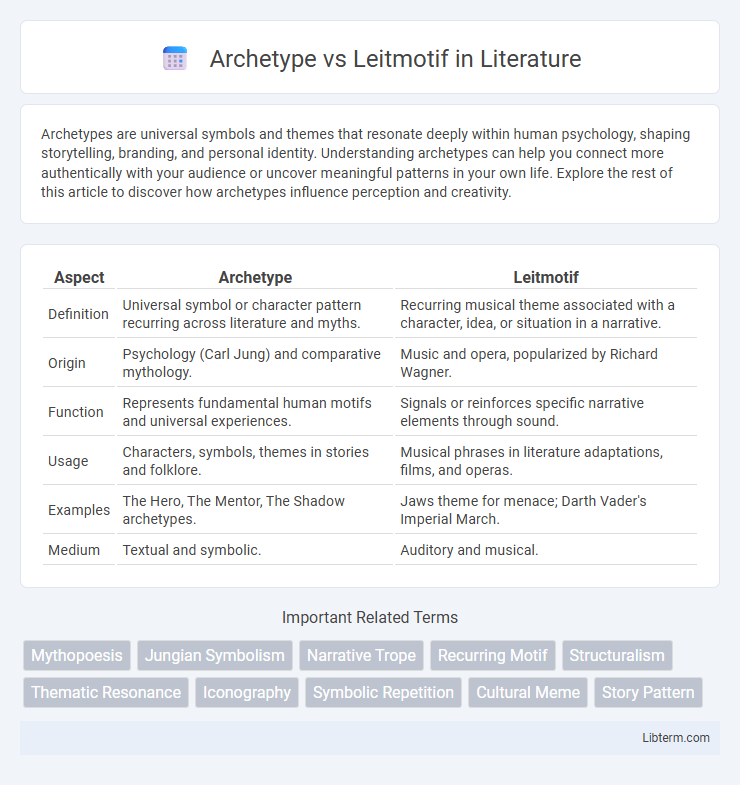Archetypes are universal symbols and themes that resonate deeply within human psychology, shaping storytelling, branding, and personal identity. Understanding archetypes can help you connect more authentically with your audience or uncover meaningful patterns in your own life. Explore the rest of this article to discover how archetypes influence perception and creativity.
Table of Comparison
| Aspect | Archetype | Leitmotif |
|---|---|---|
| Definition | Universal symbol or character pattern recurring across literature and myths. | Recurring musical theme associated with a character, idea, or situation in a narrative. |
| Origin | Psychology (Carl Jung) and comparative mythology. | Music and opera, popularized by Richard Wagner. |
| Function | Represents fundamental human motifs and universal experiences. | Signals or reinforces specific narrative elements through sound. |
| Usage | Characters, symbols, themes in stories and folklore. | Musical phrases in literature adaptations, films, and operas. |
| Examples | The Hero, The Mentor, The Shadow archetypes. | Jaws theme for menace; Darth Vader's Imperial March. |
| Medium | Textual and symbolic. | Auditory and musical. |
Understanding Archetypes: A Timeless Narrative Framework
Archetypes serve as timeless narrative frameworks that embody universal patterns of human experience, recurring across myths, literature, and art to evoke deep emotional resonance. Unlike leitmotifs, which are specific musical themes tied to particular characters or ideas within a story, archetypes function as fundamental symbols and roles such as the Hero, Mentor, or Shadow that shape storytelling structure. Understanding archetypes enables creators to craft compelling narratives by tapping into shared cultural and psychological motifs that resonate universally.
What is a Leitmotif? Defining Recurring Themes
A leitmotif is a recurring musical or thematic element associated with a particular character, idea, or situation within a work, commonly used in operas, films, and literature to create emotional resonance and narrative coherence. Unlike archetypes, which are universal symbols or motifs reflecting fundamental human experiences, leitmotifs serve as specific, identifiable patterns that reinforce storytelling and character development through repetition. Composers like Richard Wagner pioneered leitmotifs by linking melodies to narrative elements, making them crucial for thematic continuity and audience recognition.
Archetype vs Leitmotif: Key Conceptual Differences
Archetypes are universal symbols or themes recurring across cultures and literature, representing fundamental human experiences like the hero, the mentor, or the trickster. Leitmotifs are specific musical phrases or motifs associated with particular characters, ideas, or settings in a composition, used to evoke emotions or signify narrative elements. The key conceptual difference lies in archetypes as broad, timeless narrative patterns, while leitmotifs function as precise, audible identifiers within a specific artistic work.
Historical Origins: Tracing Archetypes and Leitmotifs
Archetypes originate from Carl Jung's theories, depicting universal symbols and characters embedded in the collective unconscious across cultures and history. Leitmotifs trace back to 19th-century opera, particularly Richard Wagner, who used recurring musical themes to represent characters or ideas, enhancing narrative continuity. Both concepts serve to connect audiences with underlying meanings, one through shared psychological patterns and the other through musical repetition.
Literary Applications: Archetype and Leitmotif in Storytelling
Archetypes are universal symbols or character types that recur across literature, providing a foundational framework for storytelling and resonating with collective human experiences. Leitmotifs involve recurring themes, phrases, or images that reinforce narrative elements, often used to evoke emotional responses or highlight character development. In literary applications, archetypes establish the story's core structure, while leitmotifs enhance depth and coherence by mapping thematic continuity throughout the narrative.
Film and Music: How Leitmotifs Shape Emotional Response
Leitmotifs in film and music function as recurring musical themes tied to specific characters, places, or ideas, enhancing emotional resonance and narrative cohesion. These motifs leverage associative memory, guiding audiences' feelings and expectations through subtle variations in melody, harmony, or rhythm. Unlike archetypes, which represent universal symbolic patterns or character types, leitmotifs directly influence emotional response by providing auditory cues that deepen the storytelling experience.
Psychological Perspectives: Archetype in Jungian Theory
In Jungian theory, archetypes are universal, innate symbols embedded in the collective unconscious, shaping human experiences and behaviors across cultures. Unlike leitmotifs, which are recurring musical or thematic elements tied to specific characters or ideas in art and literature, archetypes function as fundamental psychological patterns influencing identity and motivation. Understanding archetypes aids in exploring the deep-seated structures of the psyche, revealing how collective unconscious content manifests in personal and cultural narratives.
Common Examples: Archetypes Across Genres
Archetypes serve as universal symbols found in characters, themes, and settings across genres, such as the Hero, the Mentor, and the Shadow in literature and film. Common archetypes include the Innocent in fairy tales, the Outlaw in westerns, and the Sage in fantasy narratives, reflecting timeless human experiences and values. These recurring patterns provide audiences with familiar frameworks that authors adapt to create meaningful and resonant stories.
Classic Leitmotifs: Memorable Motifs in Cinema and Music
Classic leitmotifs are recurring musical themes closely associated with particular characters, locations, or ideas in cinema and music, enhancing narrative cohesion and emotional resonance. Unlike archetypes, which represent universal symbolic characters or themes found across stories, leitmotifs serve as specific audio signatures that cue audiences to particular narrative elements. Iconic examples include John Williams' use of distinct leitmotifs in Star Wars to identify characters like Darth Vader or themes such as the Force, making them instantly memorable and integral to storytelling.
Creative Uses Today: Blending Archetypes and Leitmotifs
Contemporary creators often blend archetypes and leitmotifs to deepen narrative resonance and emotional impact, using archetypes as universal character models while assigning leitmotifs as recurring musical or thematic cues to reinforce identity and development. Films like "Star Wars" effectively integrate the Hero archetype with distinctive leitmotifs such as the "Force Theme," creating multilayered storytelling that enhances audience recognition and emotional connection. This fusion allows for innovative storytelling techniques in modern media, enriching character arcs and thematic coherence across diverse platforms.
Archetype Infographic

 libterm.com
libterm.com